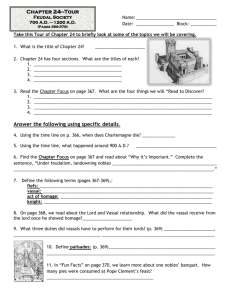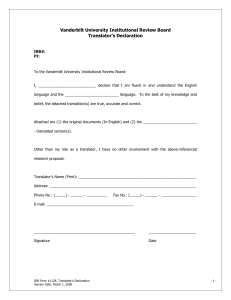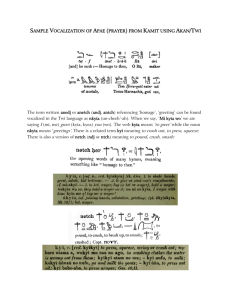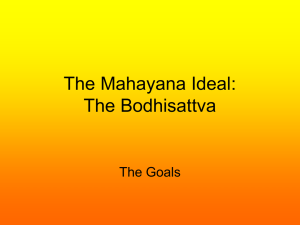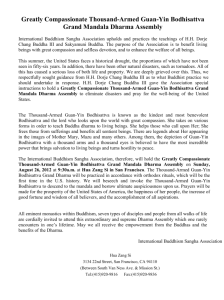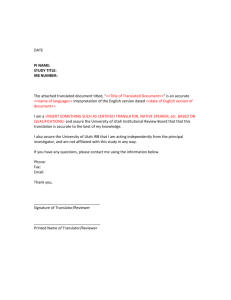The Title, Translator's Homage & The Author
advertisement
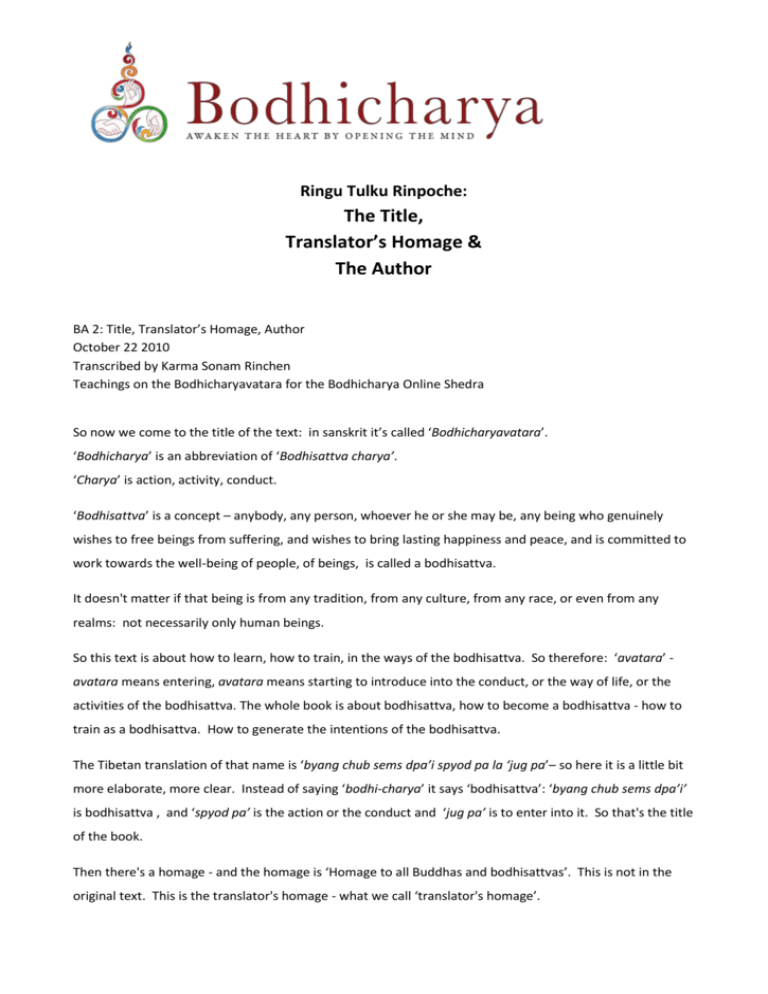
Ringu Tulku Rinpoche: The Title, Translator’s Homage & The Author BA 2: Title, Translator’s Homage, Author October 22 2010 Transcribed by Karma Sonam Rinchen Teachings on the Bodhicharyavatara for the Bodhicharya Online Shedra So now we come to the title of the text: in sanskrit it’s called ‘Bodhicharyavatara’. ‘Bodhicharya’ is an abbreviation of ‘Bodhisattva charya’. ‘Charya’ is action, activity, conduct. ‘Bodhisattva’ is a concept – anybody, any person, whoever he or she may be, any being who genuinely wishes to free beings from suffering, and wishes to bring lasting happiness and peace, and is committed to work towards the well-being of people, of beings, is called a bodhisattva. It doesn't matter if that being is from any tradition, from any culture, from any race, or even from any realms: not necessarily only human beings. So this text is about how to learn, how to train, in the ways of the bodhisattva. So therefore: ‘avatara’ avatara means entering, avatara means starting to introduce into the conduct, or the way of life, or the activities of the bodhisattva. The whole book is about bodhisattva, how to become a bodhisattva - how to train as a bodhisattva. How to generate the intentions of the bodhisattva. The Tibetan translation of that name is ‘byang chub sems dpa’i spyod pa la ‘jug pa’– so here it is a little bit more elaborate, more clear. Instead of saying ‘bodhi-charya’ it says ‘bodhisattva’: ‘byang chub sems dpa’i’ is bodhisattva , and ‘spyod pa’ is the action or the conduct and ‘jug pa’ is to enter into it. So that's the title of the book. Then there's a homage - and the homage is ‘Homage to all Buddhas and bodhisattvas’. This is not in the original text. This is the translator's homage - what we call ‘translator's homage’. This is also important to mention here - that every book that was translated into Tibetan, they always kept the title of the book in the original language as well as its Tibetan translation - to acknowledge where it came from, and to also show the respect for its source and origin. So for every book that’s been translated into Tibetan, in the beginning there is the Sanskrit name, Sanskrit title, then its translation of the title, then there is the homage of the translator. This is the translator’s prayer, you can say, or homage, so that the work that he or she would translate becomes without obstacles and smooth. But this homage also shows something really important because it shows which category of the teachings the book belongs to. It was decided, when the first translation work was going on, and then during the time of King Trisong Detsen, and then later during the second-generation or third-generation time, of King Tri Ralpachen, during that time, they decided that the translator’s homage should be according to the category of the teachings. So here it is said ‘Homage to all the Buddhas and Bodhisattvas’. Now this means this text belongs to the sutrayana sutras. Generally we have three pitakas - the Buddha’s teachings are categorized into three pitakas: the vinaya pitaka, the abidharma pitaka and the sutrayana pitaka. So it was decided that for all the texts belonging to the vinaya pitaka the translator's homage would be ‘Homage to the Buddha’. And for all the teachings that are in the category of the abidharma then the translator's homage would be ‘Homage to Manjusri’. And all the teachings in the sutrayana category, not only the teachings of the Buddha, but its commentaries as well, then the translator's homage will be ‘Homage to the Buddhas and bodhisattva's’ because sutras are mostly discussions between the Buddha and bodhisattvas and some of his students. So that's the homage of the translator. Now we come to the first chapter of this book, the title of which, in English, is translated as ‘The way of the bodhisattva’ by Shantideva. Shantideva was a very mysterious master. He was actually a prince from the south of India, and when he was very young he was introduced to Buddhism and then he practiced Manjusri - he had a special connection with the bodhisattva Manjusri and he practiced Manjusri and he had great devotion to him. And when he was about to be enthroned as the king he had a dream. In that dream he saw that Manjusri was sitting on the throne that he was to sit on the next morning and then Manjusri was saying ‘How dare you sit on my throne!’ And he took that as a sign that he should not become the king and he ran away and became a monk and practiced dharma, and travelled all over India. He lived in Nalanda University for a long time, or at least for some time. And during that time it is said that he seemed to be not doing anything - neither studying nor going to the classes, not meditating - he seemed to be not teaching, not doing anything. So people started to call him Busuku, meaning ‘eating, shitting and sleeping’. Therefore the university authorities saw him as a bad example and wanted to drive him out but they didn't know how to because he didn't break any rules. Then somebody thought he had a very bright idea, and 2 they all agreed to make a new kind of rule that every student, every teacher in the university had to give a speech. They asked Shantideva or Busuku to start this new system, and asked him to give a teaching. And in order to embarrass him they made a big throne of bricks in a very big open-air place and asked all the students and teachers of the university to come and listen to him. So Shantideva came, sat on the throne, and said ‘What kind of a teaching should I give? Should I give something that's already been given? Or something that is not given yet, or not known?’ So of course everybody shouted ‘Something new’. Then he started to recite the ‘Bodhicharyavatara’. It's in stanza form, it’s in verse. It's in very beautiful Sanskrit. The translation in Tibetan is as beautiful as it is in Sanskrit. It's simple, inspiring - directly touching your heart. So therefore this text then became… everybody was completely astonished. And it is even said that while he was reciting this text, at a certain stage, he kind of levitated from his throne and went higher and higher and disappeared. People took notes and memorized them and there were some differences afterwards. And then they tried to find him, and they found him after many years and they clarified. And this became then a very important textbook of Mahayana Buddhism both in India and in Tibet. There are countless commentaries on it, both by the Indian masters and also in Tibet. This is regarded as one of the most important text books, a classic. So therefore we decided to take this text as the first to study in Buddhism. This text has ten chapters. The first chapter is on ‘The excellence of bodhichitta’. In Tibetan it says ‘The qualities of bodhichitta: what is the benefit of bodhichitta?’ So I will talk about that. We will start this chapter in the next talk. So I think I will stop here this morning. Thank you very much. ©Ringu Tulku 3
